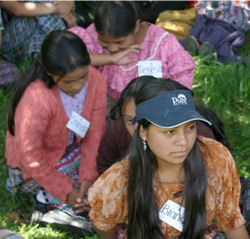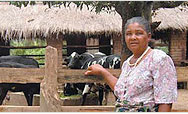Child Marriage: Latest News
Child Marriage UN Panel
 |
| 40% of Mayan girls marry before the age 18, leading to early school drop out, high illiteracy rates, and limited opportunties for their lives.
|
On February 29, 2008 Katherine Blakeslee, Director of the Office of Women in Development (EGAT/WID), moderated a panel on child marriage,
under the sponsorship of the U.S. Mission to the United Nations, during the 52nd session of the Commission on the Status of Women.
The panel, Child Marriage: Promising Approaches for Prevention, highlighted activities that USAID supports to decrease the incidence
of underage marriage of girls. The four panelists highlighted work in Bangladesh, Vietnam, Guatemala, Ghana, Malawi and Ethiopia.
Panel Presentations
Sajeda Amin, PhD, Senior Associate, Program on Poverty, Gender, and Youth, Population Council
 Programs to Address Child Marriage: Framing the Problem 02/29/2008 (203KB)
This presentation describes the various factors leading to early marriage in three contexts -- in Bangladesh, among Guatemala's Mayan population, and among the Hmong and Dao minorities in Vietnam -- and the implications for programs aiming to delay marriage in these different contexts (for instance, in Bangladesh, dowry price rises with age). In addition, it explains that a lack of opportunities and social isolation are important common correlates of early marriage among disadvantaged ethnic minorities in Asia and Latin America.
Sarah Banashek, Deputy Director, The Safe Schools Program
 Gender-Based Violence In Schools: An Entry Point for Addressing Child Marriage 02/29/2008 (841KB)
This presentation explains how the Safe Schools Program is helping to prevent child marriage in Malawi. It profiles several young girls who the Safe Schools Program helped stay or re-enroll in school. A total of 35 child marriages were avoided between October and December 2007.
Seifu Tadesse, Project Manager, Healthy Unions Project
 Stopping Child Marriage: Lessons from Ethiopia 02/29/2008 (166KB)
This presentation discusses the problem of child marriage in Ethiopia, which is due to poverty and lack of opportunity, and the lessons learned from development programs there. It explains the social change approach to stopping child marriage, which involves understanding the cultural context, including and forming strategic alliances with different members of society, and integrating with larger programs.
Anastasia J. Gage, PhD, MEASURE Evaluation/Tulane Principal Investigator and Associate Professor
 Promising Interventions: Preliminary Findings from the Amhara Region, Ethiopia 2/29/2008 (85KB)
This presentation describes interventions to stop child marriage in Ethiopia that have been implemented by World Learning and Pathfinder International. The range of interventions includes school-based, community-based, and partnerships with national and regional legal/civil society organizations. Promising preliminary findings on child marriage are also presented.
 |
| Community-based interventions, such as working with religious leaders to discourage child marriage, have had visbile impact on reducing the number of marriages of underage girls.
In the above graph, green columns are blessed marriages with girls under age 15, 15-17, and above 18 in USAID Program areas and purple are blessed marriages in non-USAID program areas.
|
Back to Top ^
|




